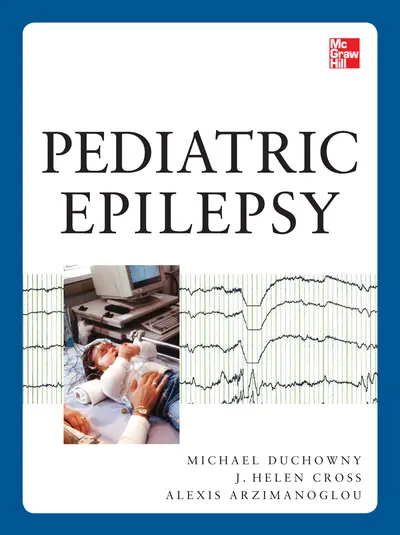My Account Details

ISBN10: 0071496211 | ISBN13: 9780071496216

Step 1 . Download Adobe Digital Editions to your PC or Mac desktop/laptop.
Step 2. Register and authorize your Adobe ID (optional). To access your eBook on multiple devices, first create an Adobe ID at account.adobe.com. Then, open Adobe Digital Editions, go to the Help menu, and select "Authorize Computer" to link your Adobe ID.
Step 3. Open Your eBook. Use Adobe Digital Editions to open the file. If the eBook doesn’t open, contact customer service for assistance.
Publisher's Note: Products purchased from Third Party sellers are not guaranteed by the publisher for quality, authenticity, or access to any online entitlements included with the product.
Practical, easy-to-follow guidance on every aspect of the diagnosis and treatment of epilepsy in children
350 full-color illustrations
Pediatric Epilepsy comprehensively addresses the needs of all physicians treating children with epilepsy – from the specialized pediatric epileptologist to the general pediatric practitioner. Written by a team of international experts, this full-color text offers a consistent, age-based approach to the diagnosis and treatment of every type of seizure and epilepsy syndrome that may occur in childhood. The book’s primary focus is on specific treatment modalities, both surgical and medical.
Features
- Algorithms and drug-dosage tables throughout emphasize patient care
- Includes first, second, and combination drug treatments with recommended starting ranges and other essential information
- Specific types of seizures and syndromes are organized by the age group in which they most often present
- Logically organized by age group, then by the seizures and syndromes that tend to first occur at those ages
- Co-morbidities section addresses illnesses caused by epilepsy treatment and illnesses that often present with epilepsy treatment
- International authorship by a team of five award-winning pediatric epileptologists
- 350 full-color illustrations
1 Epileptic Seizures and Their Classification
2 Networks and Systems in Epileptic Seizures
3 EEGs: When, How, and Why
4 Sources of Error in EEG Interpretation
5 Aims and Rationale of Anatomic Brain Imaging
6 When and Why Perform Functional Brain Imaging: Medical and Surgical Treatment of Pediatric Epilepsy
7 The Role of Guidelines in the Management of Childhood Epilepsy
SECTION II Seizures in the Newborn and Infant
8 Benign Neonatal Convulsions
9 Provoked and Nonprovoked Neonatal Seizures
10 Focal Seizures in Infancy
11 Generalized Seizures in Early Childhood (2–4 Years of Age)
12 Neonatal Epilepsies with Suppression–Burst Pattern
13 Benign Myoclonic Epilepsy in Infancy
14 Severe Myoclonic Epilepsy of Infancy (Dravet Syndrome)
15 Errors of Metabolism in the Neonatal Period
16 Episodes in Neonates, Infants, and Toddlers Mimicking Epilepsy
SECTION III Seizures in Childhood
17 Febrile Seizures
18 Focal Seizures in Early Childhood
19 Focal Seizures in Older Childhood and Adolescence
20 Generalized Seizures in Childhood and Adolescence
21 Childhood Absence Epilepsy and Myoclonic Absence Epilepsy
22 Episodic Events Mimicking Seizures in Childhood and Adolescence
SECTION IV Seizures in Adolescence
23 Juvenile Myoclonic Epilepsy
24 Generalized Tonic–Clonic Seizures on Awakening
SECTION V Epilepsy Syndromes
25 Benign Epilepsy with Centrotemporal Spikes (BECTS)
26 Benign Occipital Epilepsies
27 Autosomal Dominant Nocturnal Frontal Lobe Epilepsy
28 Infantile Spasms and West Syndrome
29 Lennox–Gastaut and Related Syndromes
30 Acquired Epileptic Aphasia (Landau–Kleffner Syndrome)
31 Reflex Epilepsy
SECTION VI Epilepsy and Neurological Disorders
32 Tuberous Sclerosis Complex
33 Sturge–Weber Syndrome
34 Epilepsy Associated with Chromosomal Disorders
35 Hypothalamic Hamartoma and Gelastic Epilepsy
36 Hemispheric Disorders Associated with Cortical Malformation
37 Rasmussen Syndrome
SECTION VII Status Epilepticus
38 Convulsive Status Epilepticus
39 Nonconvulsive Status Epilepticus
SECTION VIII CoMorbid Disorders
40 Cognitive Deficits in Children with Epilepsy
41 Learning Disabilities and ADHD in Children with Epilepsy
42 Depression and Anxiety Disorders in Children with Epilepsy
43 Autism in Children with Epilepsy: Diagnosis and Treatment
44 Treating Epilepsy in the Presence of Sleep Disorders
45 Impact of Comorbidities on Health Outcomes
SECTION IX Medical, Dietar y, and Nursing Treatment
46 Medical and Surgical Treatment of Pediatric Epilepsy
47 Antiepileptic Drugs: How to Choose
48 Antiepileptic Drug Follow-up and Withdrawal
49 Clinical Trials Versus Anecdotal Reports
50 A Practical Guide to AED Pharmacology
51 Teratogenicity of Antiepileptic Drugs
52 Comorbidities of Treatment with Antiepileptic Drugs
53 Ketogenic Diets
54 Nursing Considerations in Epilepsy Treatment
SECTION X Surgical Treatment
55 Surgery for Focal Epilepsy—Why and When?
56 Surgery for Catastrophic Epilepsies: When and Why?
57 Vagus Nerve Stimulation
58 Comorbidities of Surgical Treatment
Need support? We're here to help - Get real-world support and resources every step of the way.